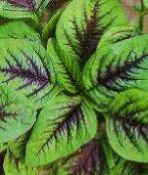Amaranthus tricolor
African or Chinese spinach, Tampala, Bledo
Tropical/ Sub-tropical
Introduction
Amaranths make up a large well-known family of primarily tropical plants. Most species are pioneer plants whose natural niche is to quickly colonize disturbed land. They produce a huge number of fast germinating seeds and this may be why they are given the name amaranth, which means "life everlasting". This is also the reason some amaranths, including red root pigweed and spiny amaranth, become serious garden and farm weeds. Amaranths use the C-4 photosynthetic mechanism, common in desert plants, that enables them to thrive in hot, dry weather.
All amaranths have edible seeds and edible leaves, but they are frequently divided into species grown primarily for the seeds and ones grown for the leaves. Seed amaranths are native to Central America, while the leafy type is thought to have originated in India. Amaranth was one of the first crops domesticated in the New World. Seeds of cultivated Amaranthus cruentus were found in a cave in Vera Cruz, Mexico dating back over 6,000 years. The Aztecs of Mexico had children separate out the rare white seeds from the black until they produced an all white seeded variety. This was lower in tannins and saponins and thus tastier and more nutritious. Amaranth was sacred to the Aztecs, who mixed ground seed with human blood in certain religious ceremonies. This practice was unacceptable to the Christian Spanish conquerors who banned the growing or possession of amaranth under penalty of death. Because of this, the plant was grown in secret and improved varieties were maintained for hundreds of years in hidden valleys of Central Mexico.
Pros
- A very popular, tender and tasty dark green leafy vegetable
- Can produce huge yields of 10 tons per hectare edible greens in 30-40 days.
- Comes up quickly, can often be harvested in 3-4 weeks
- Seed readily available
- Regrows so that up to 4 leaf harvests can be made before replanting if plants are cut back to encourage lateral growth for later harvest.
- Protein quality is excellent for leaf crop
- Amaranth can tolerate high aluminum content in soil. High aluminum levels in the soil are often a factor limiting growth in tropical areas where malnutrition is prevalent.
Cons
- Very sensitive to cold weather
- Relatively high calcium oxalate content, which makes the calcium less available in the human diet
- When grown with soluble nitrogen fertilizer, amaranths can accumulate dangerous levels of nitrates in their leaves. This problem is worse during dry weather or when the plants are grown in a greenhouse. Nitrates are especially a problem for babies and young children.
- Susceptible to damping off and other fungal diseases especially when the plants are young and the weather is rainy
- Slugs and snails often damage young plants
- Susceptible to damage from chewing insects. Generally, vegetable type amaranths have more trouble with insects than grain type amaranths
- Doesn't grow well during long periods of cloudy or rainy weather or in partial shade
- Prone to bolting (premature setting of seed)
Notes
- A common practice is to thinly sow or broadcast amaranth seed, and about 20–30 days later, thinned and surplus seedlings are used for transplants or eaten as potherbs.
- Because the seed is very small, it is often mixed with sand to make even broadcasting easier.
- Several amaranth species, including A.cruentus, A. hypochondriacus, A. caudatus are grown for grain-like seeds. Often green shoots and thinnings from these crops are eaten casually as greens.
- While most leaf amaranths are between one and three feet high, some varieties grow up to seven feet (2 meters).
- Some amaranths have red striations in their leaves due to the presence of anthocyanins. These can be very attractive and are sometimes grown as edible ornamentals.
Seeds
- ECHO; J.L. Hudson Seedsman; Redwood City Seed Co; Burpee & Co;
B &T Associates; Johnny's Seeds; Seeds of Change; Shepherds; many others.
Related Plants with Edible Leaves
Amaranthus lividus; A. gangeticus;A. blitum; A. dubious; A. cudatus; A. cruentus; A. hybridus; A. retroflesus; A. spinosa; Alternathera sessilis (sissoo spinach); Celosia argentea (quail grass or soko); Celosia cristata (cockscomb)
